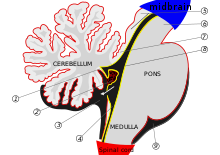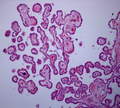Choroid plexus
| Choroid plexus | |
|---|---|
 Choroid plexus shown in the fourth ventricle | |
 | |
| Details | |
| Identifiers | |
| Latin | plexus choroideus |
| MeSH | D002831 |
| NeuroNames | 1377 |
| TA98 | A14.1.09.279 A14.1.01.307 A14.1.01.306 A14.1.01.304 A14.1.05.715 |
| TA2 | 5654, 5786, 5980 |
| FMA | 61934 |
| Anatomical terms of neuroanatomy | |
The choroid plexus, or plica choroidea, is a plexus of cells that arises from the tela choroidea in each of the ventricles of the brain.[1] Regions of the choroid plexus produce and secrete most of the cerebrospinal fluid (CSF) of the central nervous system.[2][3] The choroid plexus consists of modified ependymal cells surrounding a core of capillaries and loose connective tissue.[3] Multiple cilia on the ependymal cells move to circulate the cerebrospinal fluid.[4]
Structure
[edit]Location
[edit]
1: Inferior medullary velum
2: Choroid plexus
3: Cisterna magna of subarachnoid space
4: Central canal
5: Corpora quadrigemina
6: Cerebral peduncle
7: Superior medullary velum
8: Ependymal lining of ventricle
9: Pontine cistern of subarachnoid space
There is a choroid plexus in each of the four ventricles. In the lateral ventricles, it is found in the body, and continued in an enlarged amount in the atrium. There is no choroid plexus in the anterior horn. In the third ventricle, there is a small amount in the roof that is continuous with that in the body, via the interventricular foramina, the channels that connect the lateral ventricles with the third ventricle. A choroid plexus is in part of the roof of the fourth ventricle.
Microanatomy
[edit]The choroid plexus consists of a layer of cuboidal epithelial cells surrounding a core of capillaries and loose connective tissue.[3] The epithelium of the choroid plexus is continuous with the ependymal cell layer (ventricular layer) that lines the ventricular system.[5] Progenitor ependymal cells are monociliated but they differentiate into multiciliated ependymal cells.[6][7] Unlike the ependyma, the choroid plexus epithelial layer has tight junctions[8] between the cells on the side facing the ventricle (apical surface). These tight junctions prevent the majority of substances from crossing the cell layer into the cerebrospinal fluid (CSF); thus the choroid plexus acts as a blood–CSF barrier. The choroid plexus folds into many villi around each capillary, creating frond-like processes that project into the ventricles. The villi, along with a brush border of microvilli, greatly increase the surface area of the choroid plexus.[citation needed] CSF is formed as plasma is filtered from the blood through the epithelial cells. Choroid plexus epithelial cells actively transport sodium ions into the ventricles and water follows the resulting osmotic gradient.[9]
The choroid plexus consists of many capillaries, separated from the ventricles by choroid epithelial cells. Fluid filters through these cells from blood to become cerebrospinal fluid. There is also much active transport of substances into, and out of, the CSF as it is made.
Function
[edit]
The choroid plexus regulates the production and composition of cerebrospinal fluid (CSF), that provides the protective buoyancy for the brain.[2][10] CSF acts as a medium for the glymphatic filtration system that facilitates the removal of metabolic waste from the brain, and the exchange of biomolecules and xenobiotics into and out of the brain.[10][11] In this way the choroid plexus has a very important role in helping to maintain the delicate extracellular environment required by the brain to function optimally.
The choroid plexus is also a major source of transferrin secretion that plays a part in iron homeostasis in the brain.[12][13]
Blood–cerebrospinal fluid barrier
[edit]The blood–cerebrospinal fluid barrier (BCSFB) is a fluid–brain barrier that is composed of a pair of membranes that separate blood from CSF at the capillary level and CSF from brain tissue.[14] The blood–CSF boundary at the choroid plexus is a membrane composed of epithelial cells and tight junctions that link them.[14] There is a CSF-brain barrier at the level of the pia mater, but only in the embryo.[15]
Similar to the blood–brain barrier, the blood–CSF barrier functions to prevent the passage of most blood-borne substances into the brain, while selectively permitting the passage of specific substances (such as nutrients) into the brain and facilitating the removal of brain metabolites and metabolic products into the blood.[14][16] Despite the similar function between the BBB and BCSFB, each facilitates the transport of different substances into the brain due to the distinctive structural characteristics of each of the two barrier systems.[14] For a number of substances, the BCSFB is the primary site of entry into brain tissue.[14]
The blood–cerebrospinal fluid barrier has also been shown to modulate the entry of leukocytes from the blood to the central nervous system. The choroid plexus cells secrete cytokines that recruit monocyte-derived macrophages, among other cells, to the brain. This cellular trafficking has implications both in normal brain homeostasis and in neuroinflammatory processes.[17]
Clinical significance
[edit]Choroid plexus cysts
[edit]During fetal development, some choroid plexus cysts may form. These fluid-filled cysts can be detected by a detailed second trimester ultrasound. The finding is relatively common, with a prevalence of ~1%. Choroid plexus cysts are usually an isolated finding.[18] The cysts typically disappear later during pregnancy, and are usually harmless. They have no effect on infant and early childhood development.[19]
Choroid plexus cysts are associated with a 1% risk of fetal aneuploidy.[20] The risk of aneuploidy increases to 10.5-12% if other risk factors or ultrasound findings are noted. Size, location, disappearance or progression, and whether the cysts are found on both sides or not do not affect the risk of aneuploidy. 44-50% of Edwards syndrome (trisomy 18) cases will present with choroid plexus cysts, as well 1.4% of Down syndrome (trisomy 21) cases. ~75% of abnormal karyotypes associated with choroid plexus cysts are trisomy 18, while the remainder are trisomy 21.[18]
Other
[edit]There are three graded types of choroid plexus tumor that mainly affect young children. These types of cancer are rare.
Etymology
[edit]Choroid plexus translates from the Latin plexus chorioides,[21] which mirrors Ancient Greek χοριοειδές πλέγμα.[22] The word chorion was used by Galen to refer to the outer membrane enclosing the fetus. Both meanings of the word plexus are given as pleating, or braiding.[22] As often happens language changes and the use of both choroid or chorioid is both accepted. Nomina Anatomica (now Terminologia Anatomica) reflected this dual usage.[citation needed]
Additional images
[edit]-
Coronal section of inferior horn of lateral ventricle.
-
Choroid plexus histology 40x
-
Choroid plexus
-
Choroid plexus
-
Choroid plexus
See also
[edit]References
[edit]![]() This article incorporates text in the public domain from page 798 of page 841 of page 816 of the 20th edition of Gray's Anatomy (1918)
This article incorporates text in the public domain from page 798 of page 841 of page 816 of the 20th edition of Gray's Anatomy (1918)
- ^ Sadler, T. (2010). Langman's medical embryology (11th ed.). Philadelphia: Lippincott William & Wilkins. p. 305. ISBN 978-0-7817-9069-7.
- ^ a b Damkier, HH; Brown, PD; Praetorius, J (October 2013). "Cerebrospinal fluid secretion by the choroid plexus" (PDF). Physiological Reviews. 93 (4): 1847–92. doi:10.1152/physrev.00004.2013. PMID 24137023. S2CID 11473603.
- ^ a b c Lun, MP; Monuki, ES; Lehtinen, MK (August 2015). "Development and functions of the choroid plexus-cerebrospinal fluid system". Nature Reviews. Neuroscience. 16 (8): 445–57. doi:10.1038/nrn3921. PMC 4629451. PMID 26174708.
- ^ Takeda, S; Narita, K (February 2012). "Structure and function of vertebrate cilia, towards a new taxonomy". Differentiation; Research in Biological Diversity. 83 (2): S4-11. doi:10.1016/j.diff.2011.11.002. PMID 22118931.
- ^ Javed K, Reddy V, Lui F (1 January 2022). Neuroanatomy, Choroid Plexus. StatPearls. PMID 30844183.
- ^ Delgehyr, N; Meunier, A; Faucourt, M; Bosch Grau, M; Strehl, L; Janke, C; Spassky, N (2015). Ependymal cell differentiation, from monociliated to multiciliated cells. Methods in Cell Biology. Vol. 127. pp. 19–35. doi:10.1016/bs.mcb.2015.01.004. ISBN 9780128024515. PMID 25837384.
- ^ van Leeuwen LM, Evans RJ, Jim KK, Verboom T, Fang X, Bojarczuk A, Malicki J, Johnston SA, van der Sar AM (February 2018). "A transgenic zebrafish model for the in vivo study of the blood and choroid plexus brain barriers using claudin 5". Biology Open. 7 (2): bio030494. doi:10.1242/bio.030494. PMC 5861362. PMID 29437557.
- ^ Hall, John (2011). Guyton and Hall textbook of medical physiology (12th ed.). Philadelphia, Pa.: Saunders/Elsevier. p. 749. ISBN 978-1-4160-4574-8.
- ^ Guyton AC, Hall JE (2005). Textbook of medical physiology (11th ed.). Philadelphia: W.B. Saunders. pp. 764–7. ISBN 978-0-7216-0240-0.
- ^ a b Plog BA, Nedergaard M (January 2018). "The Glymphatic System in Central Nervous System Health and Disease: Past, Present, and Future". Annual Review of Pathology. 13: 379–394. doi:10.1146/annurev-pathol-051217-111018. PMC 5803388. PMID 29195051.
- ^ Abbott NJ, Pizzo ME, Preston JE, Janigro D, Thorne RG (March 2018). "The role of brain barriers in fluid movement in the CNS: is there a 'glymphatic' system?". Acta Neuropathologica. 135 (3): 387–407. doi:10.1007/s00401-018-1812-4. PMID 29428972.
- ^ Moos, T (November 2002). "Brain iron homeostasis". Danish Medical Bulletin. 49 (4): 279–301. PMID 12553165.
- ^ Moos, T; Rosengren Nielsen, T; Skjørringe, T; Morgan, EH (December 2007). "Iron trafficking inside the brain". Journal of Neurochemistry. 103 (5): 1730–40. doi:10.1111/j.1471-4159.2007.04976.x. PMID 17953660.
- ^ a b c d e Laterra J, Keep R, Betz LA, et al. (1999). "Blood–cerebrospinal fluid barrier". Basic Neurochemistry: Molecular, Cellular and Medical Aspects (6th ed.). Philadelphia: Lippincott-Raven.
- ^ Saunders, Norman R.; Habgood, Mark D.; Møllgård, Kjeld; Dziegielewska, Katarzyna M. (2016-03-10). "The biological significance of brain barrier mechanisms: help or hindrance in drug delivery to the central nervous system?". F1000Research. 5: 313. doi:10.12688/f1000research.7378.1. ISSN 2046-1402. PMC 4786902. PMID 26998242.
The embryonic CSF-brain barrier, shown in Figure 1(f). In the ventricular zone is a temporary barrier between the CSF and brain parenchyma. In early brain development, strap junctions are present between adjacent neuroepithelial cells; these form a physical barrier restricting the movement of larger molecules, such as proteins, but not smaller molecules. At later stages of development and in the adult brain, these strap junctions are no longer present when this interface becomes ependyma.
- ^ Ueno M, Chiba Y, Murakami R, Matsumoto K, Kawauchi M, Fujihara R (April 2016). "Blood-brain barrier and blood-cerebrospinal fluid barrier in normal and pathological conditions". Brain Tumor Pathology. 33 (2): 89–96. doi:10.1007/s10014-016-0255-7. PMID 26920424. S2CID 22154007.
- ^ Schwartz M, Baruch K (January 2014). "The resolution of neuroinflammation in neurodegeneration: leukocyte recruitment via the choroid plexus". The EMBO Journal. 33 (1): 7–22. doi:10.1002/embj.201386609. PMC 3990679. PMID 24357543.
- ^ a b Drugan A, Johnson MP, Evans MI (January 2000). "Ultrasound screening for fetal chromosome anomalies". American Journal of Medical Genetics. 90 (2): 98–107. doi:10.1002/(SICI)1096-8628(20000117)90:2<98::AID-AJMG2>3.0.CO;2-H. PMID 10607945.
- ^ Digiovanni LM, Quinlan MP, Verp MS (August 1997). "Choroid plexus cysts: infant and early childhood developmental outcome". Obstetrics and Gynecology. 90 (2): 191–4. doi:10.1016/S0029-7844(97)00251-2. PMID 9241291. S2CID 40130437.
- ^ Peleg D, Yankowitz J (July 1998). "Choroid plexus cysts and aneuploidy". Journal of Medical Genetics. 35 (7): 554–7. doi:10.1136/jmg.35.7.554. PMC 1051365. PMID 9678699.
- ^ Suzuki, S., Katsumata, T., Ura, R. Fujita, T., Niizima, M. & Suzuki, H. (1936). Über die Nomina Anatomica Nova. Folia Anatomica Japonica, 14, 507-536.
- ^ a b Liddell HG, Scott R (1940). A Greek-English Lexicon. Oxford: Clarendon Press.
Sources
[edit]- Brodbelt A, Stoodley M (October 2007). "CSF pathways: a review". British Journal of Neurosurgery. 21 (5): 510–20. doi:10.1080/02688690701447420. PMID 17922324. S2CID 6901013.
- Strazielle N, Ghersi-Egea JF (July 2000). "Choroid plexus in the central nervous system: biology and physiopathology". Journal of Neuropathology and Experimental Neurology. 59 (7): 561–74. doi:10.1093/jnen/59.7.561. PMID 10901227.
External links
[edit]- 3-Dimensional images of choroid plexus (marked red)
- "Anatomy diagram: 13048.000-3". Roche Lexicon - illustrated navigator. Elsevier. Archived from the original on 2012-07-22.
- MedPix Images of Choroid Plexus
- More info at BrainInfo





